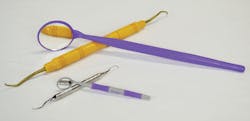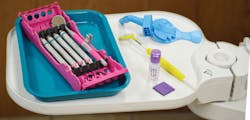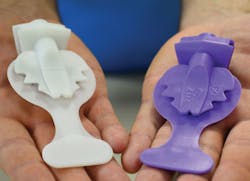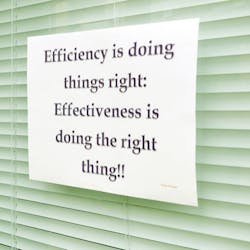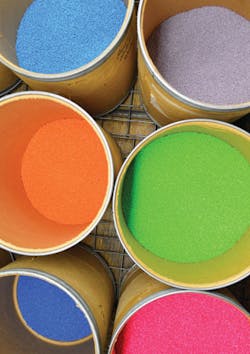Where time is everything: Zirc continues its quest to improve efficiency in the hygiene operatory
BY ANNE NUGENT GUIGNON, RDH, MPH, CSP
It's always exciting to try new products that are fun or make the clinical day easier, and it's a big bonus when something new works better than we ever imagined. The icing on the cake is getting an opportunity to work with innovative products that are made in the United States.
As I travel around the country, I periodically have the opportunity to visit factories. It is humbling to see how much innovation goes into making products that make our workday better and gratifying to see how much pride workers take in creating things that many times we take for granted. On a recent trip to Minnesota, I was able to schedule a site visit to Zirc, a small company located in Buffalo, 45 minutes west of the Twin Cities. The urban sprawl quickly changed to rolling hills full of farms preparing for spring planting. After motoring down a mix of paved county roads and dirt stretches, a building on the left came into view. There was a small sign perched on a pole featuring the Zirc logo and the tagline, "Because Time Is Everything."
Back to the fundamentals
Zirc is probably not a household name in your dental world, but without a doubt your dental hygiene practice has been using their concepts and products through the years. In the 1960s, four-handed, sit-down dentistry was first introduced. While this shift was aimed at reducing workplace stress, professionals tended to work longer hours with fewer breaks. Around the same time, dentists started working regularly with assistants, who had little familiarity with specific dental procedures and the instruments and products used for each. Zirc's founder, Jim Campion, observed high employee turnover and stressed dentists and employees. If assistants did not know the tools or materials used for each procedure, their dentist employers would quickly lose patience and fire them.
A wall of color.
Always focused on efficiency and organization, Campion initially developed the tub-and-tray concept. All the tools for a particular procedure would be preassembled on a tray or in a cassette and a tub of the same color would contain all of the corresponding supplies and materials. While these concepts seem basic today, color-coding and organizing by procedure helped dental assistants work more effectively, and therefore more efficiently. Campion's ideas grew to include banding instruments with color-coded rings to signify a procedure at a glance or to distinguish instruments between clinicians (for example, in offices where each hygienist has his or her own sets).
Fabi Plasse, RDH, who is based in Worcester, Mass., implemented the color-coded cassettes in her dental office. According to Plasse, "It's so much easier to set up and train people when each procedure has its own color. Zirc cassettes are so much lighter than metal and very durable."
-------------------------------------------------
Other articles by Guignon
- Have a seat: Ergonomic conversations turn to dental clinician seating
- Dinner with the visionaries: Imagine a conversation with four voices from the profession's past
- Deliver what they want: Dental patients disengage when we don’t acknowledge what they want
-------------------------------------------------
Four decades later, Zirc still continues to produce innovative, colorful, and durable products that can have an impact on how we deliver care and how we feel at the end of the day. While the bulk of their business continues to be the everyday workhorses such as trays, tubs, and cassettes, the company has four unique products that are particularly relevant to clinical practice today.
Unique products that help
The Crystal HD Mirror is a hands-down favorite among dental hygienists. The mirror lens is made with 75 layers of three different oxides, a unique technology that produces a brighter, cleaner, and more color-true image. Clearer images reduce visual fatigue and make using indirect vision a much more appealing option. A side-by-side comparison is all you need to realize how much easier it is to see clinically; the images produced by a traditional rhodium mirror are reminiscent of looking through a dirty windshield on a car.
Clinicians who adopt this technology will not go back to a standard mirror. Carla Purdham, RDH, of Kentucky reflected, "After using the Crystal mirror, I now realize I used to work in the dark." Joan Kenney Fitzgerald, RDH, who is based in New Hampshire and is the creator of Oral Healthcare @ Home, Inc., loves the reflective quality when she works with special needs and homebound patients.
A plethora of trays, tubs, and mirrors in the exhibit hall, including the fun Mega Mirror.
Emily Boge, RDH, MPA, got hooked on the double-sided Crystal mirrors years ago: "Dental hygiene students from Hawkeye Community College rotate through our Manchester, Iowa office. They are amazed by the amount of light bouncing off both sides. Paired with my loupes and headlight, the Crystal mirrors make visibility a snap!" California-based Renee Marchant, RDH, said, "The light reflection is beyond compare and it makes our jobs easier. You can visualize better, see calculus, decay, and everything else more acutely. Even with high-resolution loupes and a headlight, the Zirc mirror improves my visibility. I would never go back to rhodium mirrors."
Dental hygiene practice has changed significantly over the years. Power-driven scalers are now part of routine care. Newer offices have generous counter space and efficient storage cabinets so equipment placement is often easier, but many older treatment rooms are design nightmares. Clinicians are frequently expected to work with power scalers in hard-to-reach locations that force them to bend, twist, and lean to reach the controls. The end result is a clinician who is bent like a pretzel.
Zirc's E-Z Access Shelf is an easy-to-install, cost-effective solution that creates more shelf space. The E-Z Access Shelf is 12x20 inches and can hold up to 18 pounds, accommodating the size and weight of every power scaler. The shelf can be bolted to a wall or attached to the light pole via a large screw bolt. Extension arms are available to bring the tray closer to the clinical workstation. Optional items such as a saliva ejector holder or an air-water syringe support can also be added to customize the basic shelf to specific end-user needs.
Mirror Magic was introduced this year to help clean mirror surfaces and eliminate surface fogging. Attach a small pad to the back of the glove on your dominant hand, moisten the pad with Mirror Magic fluid, and wipe your mirror across the surface as needed to keep the mirror clean and fog free. Maureen Curran, RDH, of Connecticut uses Crystal HD mirrors and finds it "so much easier to swipe my mirror on the Mirror Magic pad than dipping the mirror in a cup of mouthwash that is sitting farther away."
Mr. Thirsty One-Step facilitates intraoral procedures and is a single-use, continuous suction/isolation device that also serves as a mouth prop. Imagine how much easier it would be to place a sealant with Mr. Thirsty in place. Patients are also more comfortable during procedures that require efficient fluid management such as a session involving extensive ultrasonic scaling. Mr. Thirsty comes in both pediatric and adult sizes and can be custom-trimmed to tailor to individual needs.
On with the tour
As I toured the factory, the company mantra, We don't sell products, we sell efficiency, became even more apparent. The facility is full of small and large machines that make resin dental products. Over the years, Zirc has acquired millions of dollars' worth of machines. The company purchases both new and used equipment regularly to improve both production quality and efficiency. New machines can cost well over $120,000 each, while used equipment can often be purchased for as little as $20,000 per unit. By continuously investing in new and better equipment, Zirc not only talks the talk, but is also a company that walks the walk, focusing on bringing quality products to the market.
Ninety-nine percent of Zirc products are made at the Buffalo, Minnesota, factory using different resins (i.e., high-quality, durable plastic materials). Zirc is a very self-sufficient enterprise. So what does that mean to the end user? It translates into a nimble company that can create products in an efficient manner according to customer demands. Workers are cross-trained. When production demands for a particular product go up, workers can switch to a new task, reducing boredom and increasing efficiency.
The factory has its own machine shop, so most equipment can be repaired at a moment's notice; a small machine or part can even be manufactured on site. But perhaps the most amazing thing is Zirc's incorporation of a 3D printer, a machine that creates an actual model from a computer-assisted design (CAD) in a matter of minutes. I've been hearing about these devices for a couple of years, but they never made sense to me.
The 3D printer prototype on the left is compared to the final Mr. Thirsty on the right.
Manufacturers used to rely on molds to create a design. Traditional molds typically cost $15,000 to $40,000 to make. If the design was off, it was money down the drain. Now companies can check out initial designs using a 3D printer, tweak the configuration in less time, and eliminate costly mistakes. During the tour, the Zirc design engineer handed me a "printed" prototype of the Mr. Thirsty One-Step product. By studying the actual features, the engineers were able to create both a pediatric and adult version. Clearly, 3D printing will revolutionize the manufacturing world and help keep costs down.
On the surface, plastic seems simple, but different resins are appropriate for different tasks. Big drums of colored resin beads line an entire wall in the factory. There are very precise formulas for mixing specific colors. It is a fine art to constantly produce products that are the same exact shade, can withstand the rigors of sterilization and chemical disinfection, and maintain color stability and structural integrity over repeated use. Giant vacuums suck raw materials into one side of the big machine; the finished component drops out on the other side. Speaking of colors, Zirc is working on new color palettes that will include more contemporary shades, including some with a subtle, soft European flair.
As I walked through the immaculate factory, I was constantly reminded how we need to work with excellent products that reduce workplace stress and allow us to keep our focus on treating patients. Zirc's goal is to create simple solutions that make a difference.
Everything about the Zirc factory is well organized, from the huge bins of colored resin granules to the "on-time delivery" warehouse. No one looked stressed, but everyone was busy doing his or her job. There were little signs throughout the plant that focused on creating excellence and solid customer relationships, reinforcing key goals of the company.
Unlike many companies today, Zirc is not a big corporation. It embodies many aspects of a well-run family dental practice where employees are happy and stay for years for all the right reasons - to serve patients with outstanding dentistry. Being an avid fan of Zirc products, it was a thrill to see how the products were actually made and to observe the culture of this 47-year-old Midwestern company that has quietly gained international status.
Containers of colored resin granules.
Stacie Carlson, RDH, of Minnesota actually started her working career at Zirc at age 10! Jim Campion hired Stacie and her buddies to paint little eyes on Zircies on Saturday mornings. Zircies were miniaturized, colored rubber animals used as a give-away item. It was a short-term job, but she made more money than babysitting and had fun with her friends. Years later, Stacie chose a career in dentistry and saw the usefulness of the tray-and-tub systems, and actually toured the newest facility a couple of months ago.
Not surprisingly, Nicolle Campion's 10-year-old daughter Brenna has become interested in working at the company during her summer break. Like Stacie, Brenna enjoys spending time doing simple tasks like applying labels to sample packages. She just convinced her mom to let her work again this summer. And according to Nicolle, Brenna is a diligent worker and observes regular employee time schedules during her half-day shifts. Obviously this young lady has learned many life lessons from the adults in her life.
Lasting impressions
Pat Pine, RDH, first started using Zirc's color-coding system as a dental assistant many decades ago. She remembers, "Color-coding made my life as a dental assistant and hygienist much easier. Color-coding is simple, but so helpful to all - silent communication." Perhaps the funniest story of all came from Pat. When Pat was on her way to the Phoenix Airport a while ago, the driver asked why she was going to California. Pat replied, "I'm headed to the California Dental Meeting to present infection control seminars," to which the driver responded, "I know Jim Campion, the owner of Zirc." Once again we see that the dental world is a small one!
What a treat to be able to give you a little glimpse into what it takes to make great all-American products that allow us to provide higher quality clinical care to our patients with less stress to our bodies and minds. Thank you, Zirc, because time is everything!RDH
A family-run enterprise
Through the years, I've met a handful of Zirc employees. Jim Campion, the founder, has now passed the day-in and day-out operations to his children. Fifteen years ago, Nicolle Campion came to Zirc and today heads up sales and marketing. Her brother Jon oversees financial matters; her sister Ashley, a recent college graduate, works in ISO management and quality systems. Jon's wife, Magda, recently joined the team and manages professional relations with academic institutions and speakers.
The employee turnover is low and many have been with Zirc for decades. While some companies do not allow married couples to work together, Zirc is focused on employees who share the company values, so spouses working side by side is not an issue. There are even three people from one outside family on the Zirc payroll. One woman started working in assembly two decades ago, and now her husband performs all the maintenance on the manufacturing machines; and their son manages the production facility.
Among the Zirc "family traditions" is a bulletin board to name the parents or grandparents of any new family additions. Everyone in the company gets together regularly for lunches, barbeques, and other outdoor events like picnics with games and contests. There is a Christmas party every year, complete with presents, and an annual offsite party every summer that could be a boating party on a nearby lake or a trip to a Minnesota Twins baseball game.
ANNE NUGENT GUIGNON, RDH, MPH, CSP, provides popular programs, including topics on biofilms, power driven scaling, ergonomics, hypersensitivity, and remineralization. Recipient of the 2004 Mentor of the Year Award and the 2009 ADHA Irene Newman Award, Anne has practiced clinical dental hygiene in Houston since 1971, and can be contacted at [email protected].



